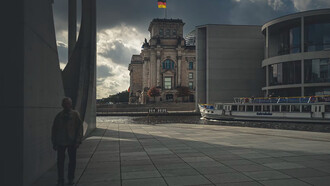The fiftieth anniversary of the 1973 military coup reopens the memory of the horrors committed by the armed forces and carabineros in 17 years of dictatorship with the connivance of civilian political sectors. The memory of President Salvador Allende, despite the defamation campaign of conservative sectors for 50 years, and lately the attempts to relativize his legacy, has secured a place in the pantheon of the greats of Chilean history. Telling the truth is not to inculcate hatred, but to educate the new generations with what happened. This is how societies such as Germany and Italy have been healed, while countries like Spain continue to this day digging up corpses to hand them over to their relatives and eliminating monuments or squares that remembered the Franco dictatorship.
Undoubtedly, today we must look to the future and strengthen democracy, armed institutions and respect for human rights. However, this should not prevent us from remembering what happened and much less in circumstances in which thousands of families live the permanent mourning of not knowing where the remains of their loved ones are. President Gabriel Boric, in his message to the nation on June 1, stated that "we will not give up on the moral duty of exhausting the necessary resources so that the families of the disappeared and executed detainees who have not been found may know the truth of what happened. When will this happen? Who, if not the armed forces and the carabineros, can answer?
Recently a question has been raised by the veto of the commander-in-chief of the army to register the military compounds where aberrations, tortures and executions of men, women and adolescents were committed as sites of historical memory. People who know what happened in those fateful days of Pinochet's dictatorship and the military junta that accompanied him, together with the support of a large part of the officer corps, intend that the sites should not be remembered, that no traces of the past should remain, that is, another way of making the memory and the places where the crimes were committed disappear: this time the memory and the places where the crimes were committed.
pIt is worth remembering some of them, such as what happened to the closest and most loyal collaborators of President Allende who were taken from the La Moneda palace on September 11, transferred to the Tacna regiment where they were humiliated and tortured, and then transferred to the Peldehue military camp. The following is one of hundreds of testimonies collected by the Vicariate of Solidarity and preserved in the Museum of Memory and Human Rights in Santiago, which were presented to the courts of justice.
According to testimonies of the survivors, they heard from the soldiers who participated in the operation that they had been taken to the military camps of Peldehue, located in Colina, where they would have been shot and buried. A soldier from the Tacna Regiment, who was able to witness part of the events, said that the prisoners were tied with wire and thrown into an Army Pegaso truck that formed part of a convoy that left the barracks at approximately 2:00 p.m., while all the conscripts were ordered to remain confined to their stables and not to move around the yards. In the afternoon the contingent that had been part of the convoy returned and word spread among the military that the prisoners had been taken to the property that the Tacna Regiment has in the military camps of Peldehue, in Colina, where they would have been killed in front of a hole or pit, about five to six meters in diameter and several meters deep, which existed a short distance from the house used by the guard personnel of the property. The prisoners were placed in groups of four at the edge of the pit and shot. Once they were executed and thrown to the bottom of the pit, grenades were thrown into the pit and the executions continued four by four. The soldier adds that it was his turn to go to the aforementioned property at the end of September 1973 and he found the aforementioned pit covered. There he was confirmed that those executed had been buried there and that there were 26 or 27 of them, who before being killed shouted slogans alluding to the Popular Unity government".
The Peldehue military camp is today the army regiment called BOE, Special Operations Brigade. Nothing there indicates the place where President Allende's collaborators were shot. When consulted, the officers say they do not know where it happened. This grave, like others, was opened years later in the so-called "Operation Television Removal", initiated in 1979, directed by military intelligence services and under direct instructions from Pinochet and the military junta. It consisted of digging up all the bodies of executed political prisoners and making them disappear, as revealed in the investigation by Judge Juan Guzmán in 2004. Therefore, this place, as well as others, should be declared "sites of historical memory" and remembered with plaques of the events that occurred. It will not mean altering the work of the military and they can be opened once a year to relatives and the public. In fact, on two occasions the BOE has received relatives of those killed in Peldehue.
The country cannot allow a double disappearance: of the remains of those who were shot and of the sites where the crimes occurred. Responsibility should not be sought in the army or other branches of defense, but mainly in those who have exercised civilian power mandated by the citizens. In more than 30 years of democracy, some of its authorities seem to continue to fall under the Stockholm syndrome, which acts as a protective mantle not to investigate further and leave in the mist of oblivion, the disappearance and death of thousands of Chileans. There will be no true peace as long as each of the institutions do not make their own recognition of what happened, ordered by a generation of superior commanders who have soiled a glorious history of fundamental institutions for the republic.
Twenty years ago, General Juan Emilio Cheyre had the courage to take the first step with his call to "never again", opening a path of encounter with the victims and history. Unfortunately, there was no continuity, leaving once again in oblivion what happened. Only in March 2022, in the hall of honor of the Military School in Santiago, General Ricardo Martínez went further by recognizing several horrors committed by his institution, among them the so-called "caravan of death" led by General Sergio Arellano. There remains for history the dishonor of the former commander in chief of the army, Augusto Pinochet, who ordered the assassination in Buenos Aires of his comrade in arms and predecessor, General Carlos Prats and his wife, Sofia Cuthbert. Let us hope that it will not take 20 more years for the army to complete and cleanse the honor of an institution that does not deserve the stain left by the 17 years of a murderous and corrupt dictatorship. The Navy has taken another step forward with the June 14 declarations of its commander-in-chief, Admiral Juan de la Maza, when he said "never again" to the horrors committed in the former prison camp of Dawson Island, located 2,290 kilometers south of Santiago. For the first time an admiral refers to the years of the dictatorship and although without condemning the actions of other commanders, he pointed out that it must not be repeated.
We hope that the Navy will contribute in the near future to clarify and open the archives where information is kept on the role they played in the years of horror. Admiral de la Maza will now have to face the criticism and insults of retired officers, who like the rest of the other armed institutions, deliver the true thinking about the military dictatorship from the comfortable and "sweet retirement", as they call it. The crucial step that the armed forces and carabineros should take, out of respect and teaching of human rights to the new generations, is to introduce in the curricula the visits of all the schools of officers and NCOs of the armed forces to the Museum of Memory and other sites like Villa Grimaldi.
The 50 years of the coup and President Allende's decision to die in La Moneda, after a fierce bombing, together with the 17 years that followed and that changed the lives of millions of people, are a page of heroism, courage and testimony that cannot be erased, much less relativized, out of respect for the memory of the victims and the more than 200 years of history of the Republic.














